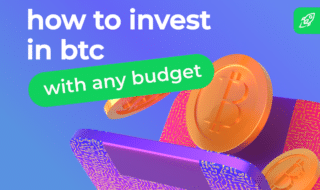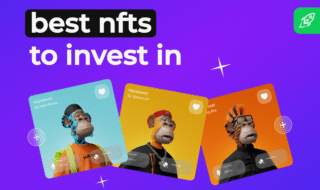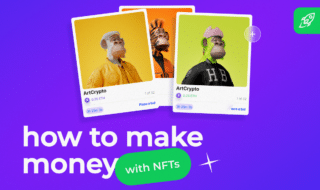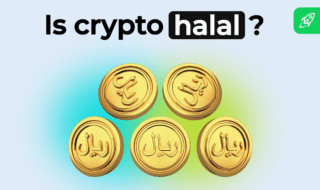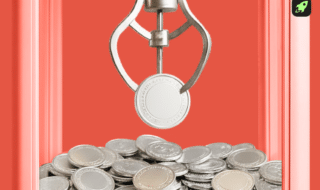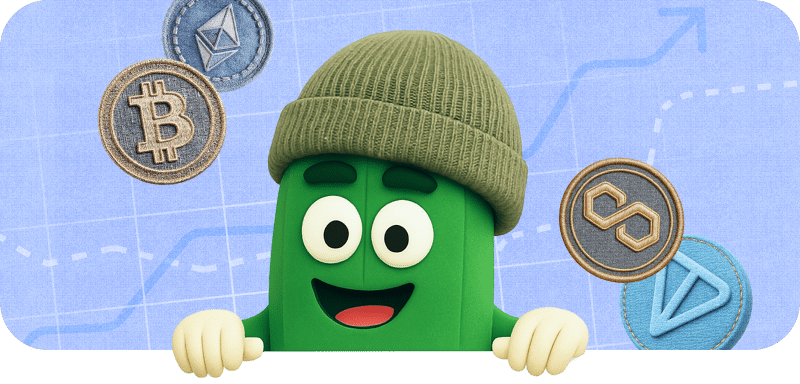There are two ways of explaining NFTs. The first one’s short and dumb, and the second is actually viable. Let’s start with the silly option: NFT is a non-fungible token. This is a brilliant and common explanation that clears out exactly nothing.
Of course, knowing what “NFT” stands for is not enough to understand it. Therefore, we need to explain the craze for these digital objects in a way so that even your grandmother will be curious to check it out.
Isn’t “digital craze” a bit of an exaggeration? Oh, no. According to NonFungible, NFT sales have grown 131 times within a year when they first became mainstream. A digital artist, Mike “Beeple” Winklemann, had turned his 5,000 drawings into NFTs, and they were later sold at Christie’s for an astonishing sum of $69.3 million.

This is not a trend but really a craze, a lethal money fever that sneakily crept onto the crypto market in 2021 to explode in hundreds of millions of dollars in profits. And not only that. NFTs are also a very special and kind way to appreciate the work of digital artists and creators.
Now, let’s explain “non-fungible token” word by word.
Read also: Ape Coin Price Prediction for 2022 and beyond
Table of Contents
Non-Fungible
It is a smart word for “unique.”*
One bitcoin can be traded for another bitcoin just like it, but you can’t exchange one NFT for another and get the same object. Bitcoins, US dollars, apples, and those tasteless mass-produced “Home Is Where Your Heart Is” mugs at Walmart are fungible.
NFTs are not, thus the name. Swapping NFTs is like trading the Mona Lisa painting for Pink Floyd’s album cover art. Both are awesome but can never be the same thing. Most non-fungible tokens are one of a kind or part of a limited edition. All of them have unique identifying codes.
Crypto-maniacs don’t have a monopoly over the term “non-fungible.” It’s a general concept. Here are some examples of other non-fungible objects:
- Any amateur or professional painting,
- A movie,
- A signed baseball card,
- Your mother’s signature dish,
- Stephen King’s short tale,
- An ugly paper pterodactyl that you made for an art project at school,
- A human being (unless you believe in the Avril Lavigne replacement conspiracy).
All of the things above have unique value, even if it’s only sentimental. There are plenty of other non-swappable things that are not NFTs. That’s because they are not tokens.
* We, an intellectual, could’ve also used the synonym “non-interchangeable,” but breaking your eyes or tongue is not the purpose of this article.
Read also: NFTs in Digital Art
Tokens
At a basic level, a token is a virtual certificate of ownership. It only exists in a digital form as a digital file and is basically a registered entry in the blockchain system. Most NFTs are part of the Ethereum blockchain — don’t ask why. Blockchain tokens are encrypted and can be stored on different devices from any part of the world. This makes stealing NFTs a “mission impossible” that even Tom Cruise wouldn’t dare to complete.
Tokens are also handy when it comes to proving your ownership. Because an encoded message (usually, an ETH token ID) that proves you own a digital Mona Lisa is stored online, you can instantly find your blockchain entry whenever, wherever. This makes NFTs one of the quickest ways to flex at a party if we’re talking personal finance.
The sale of any non-fungible tokens / NFTs will be reflected on the blockchain, with a digital record available to the public. By the way, to prove NFT’s authenticity, you only have to check an ETH token ID and contract address in the NFT market database. It’s like a digital signature.
What Are NFTs Again? The “What is NFT for Dummies” Version
In shorthand, non fungible tokens (NFTs) are unique digital items that are one of a kind or part of a limited collection of virtual objects in the art world. An NFT can be a picture, a photo, a song, video clips, game items, and even tweets (or whatever they’re called these days). They can be created by anyone from the NBA (the NBA Top Shot collection) to a random guy that made a funny video a few years ago.
NFTs are stored in blockchain systems where you can browse NFT collections. This means that you can store your non-fungible tokens in crypto wallets that support their specific standard — just like you would store your physical assets in a vault or on your shelf.
From Zero
to Crypto Hero
Learn crypto basics in 25 minutes with Pickle. Plus, grab a $100 bonus to start swapping smarter
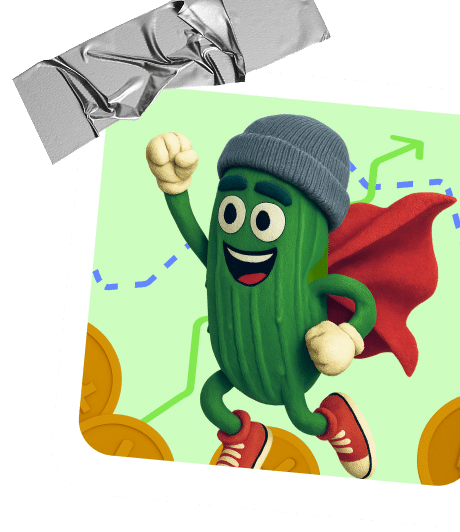

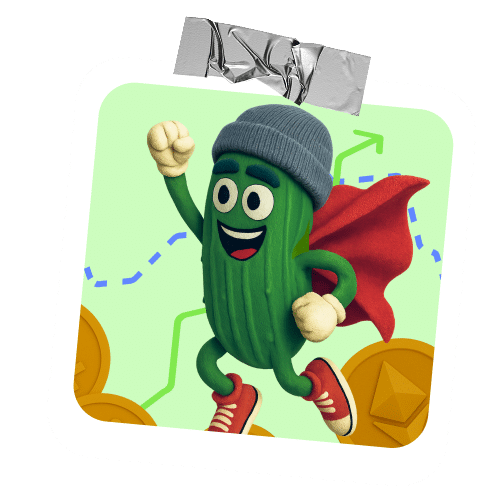
NFT Art Is Dumb and Ugly
Oh, a very rare statement indeed. It’s a question to which, were we Sotheby’s art snobs, we’d pull out our handkerchiefs (with the embroidered Changelly logo, of course) and weep aesthetically challenged tears.
First of all, weren’t you preoccupied eating that rat’s ratatouille, Mr. Critic?
Second of all… Eh, well… Some of them are made with less skill than others. Some of them are bloody masterpieces.

Look, art is an unfair and horrible affair through and through because it’s subjective. Like, the same guy who drew the Scream also made this:

Imagine the difference between screencapping Monet and owning Monet. Get it? Download some digital content, set it as your wallpaper, and be amused. That’s about it. Buy an NFT, acquire the rights to sell, use Monet (work, Monet’s work, leave poor Claude alone), and see it grow in value.
“Nifty” is an investment as valuable as the work of art it is attached to, and a screenshot is just that — a screenshot. NFTs are also a way to appreciate and reward artists you like. You can even create NFTs and try to earn physical money this way.
How Do NFT Tokens Work?
Much like crypto, NFT artworks exist on the blockchain. Blockchain systems guarantee the authenticity of non-fungible tokens and serve as public ledgers for transactions. Once, NFT projects lived only on the Ethereum blockchain. Today, you can find them on almost all popular networks, including Harmony ONE, Polygon, Solana, BNB Smart Chain, Near, Tron, Cardano, PolkaDot, and many more.
How to Buy NFTs
- You don’t need Dora the Explorer’s backpack to start your incredible NFT-buying journey on the blockchain network. Instead, you’ll have to register a crypto wallet and buy quite a few coins (or find ways of obtaining them for free).
- Once you’ve purchased Ethereum, transfer your crypto to a crypto wallet (we explained how to choose the wallet that suits your needs just right in a separate article).
- Connect the digital wallet with an NFT platform like OpenSea or any other:

4. Ta-dah! Conduct NFT transactions and start selling and trading NFTs.
Remember, even if the NFT costs next to nothing, you still have to pay a fee to complete the transaction. Make sure your wallet has the necessary amount to cover the price of an NFT + a commission to obtain the NFT ownership.
Where Are NFTs Stored?
Most NFTs “live” in the InterPlanetary File System or the Filecoin Network storage. Some companies like Trezor and Ledger provide hardware wallets to store crypto digital assets, including NFTs. They are called “cold storage.” There are a few disputes about which option for storing NFTs is safer, but both are solid, thanks to blockchain technology.
How to Sell NFTs
- To sell an NFT, grab your crypto wallet and a token itself (duh).
- For your first transaction, stick with well-known platforms like OpenSea. They don’t offer more security or anything fancy, but they have user-friendly designs and are easy to set up.
- Enter the sales page, select your digital token’s cost (any imaginable sum that pleases your ego), and the sales model: at a fixed price or through an auction.
- Choose the duration of the sale (for how long your NFT will be on the market). By default, the options are 1 day, 3 days, or a week, but you can set any other time frame using the calendar. You can also immediately reserve your NFT for your chosen buyer.
- All set, let’s roll. Oh, wait, before you actually sell, don’t forget that commissions apply to creators too: a 10% creator commission + a fixed % of a service fee. Precious coins will be automatically transferred to your wallet after the sale.
What Can Be Sold as an NFT?
Mayday, mayday, we have a creator on board!
Let’s talk about what we can turn into an NFT. It’s really not that simple. The final price of a non-fungible token depends on its uniqueness and exclusivity. It can be a GIF, an image, a creative video, or a song. What else? Tweets, gaming skins, virtual real estate, and stocks. Can it be an actual physical, tangible object? Yeah. Yeah, yeah, we’ve been lying to you all along. NFTs can exist in the real world, too. For example, someone sold their four-bedroom house using NFTs as proof of ownership. Selling NFTs is easy.
NFT World and Copyright
By itself, the token does not equate to the object that you’d like to sell. This is only a certificate confirming the individual rights of the owner associated with a particular product.
So, if you buy an NFT, you neither own the original art nor control the authorship. Content creators retain their full copyright.
What Is the Difference between NFTs and Crypto?
Similarities
- Both NFTs and crypto are built and created with the help of blockchain technology.
- They are part of the DeFi world and attract the same pool of traders.
- Crypto coins and NFTs are traceable, hard-to-hack, counterfeit-proof pieces of code.
Are they the same thing? No.
Differences
- Crypto coins are fungible. You can swap them, and the value is always the same.
- NFTs are unique, and so, they are non-fungible. NFTs represent rare items that may grow into valuable digital assets.
- Crypto is basically the run-of-the-mill money that you use to buy NFTs.
- Cryptocurrency value is purely economic. NFTs’ value can be aesthetic, sentimental, etc.
How to Invest in Non-Fungible Tokens
Some complain that NFTs are a bubble and fool’s gold. To that, we say, “Benyamin Ahmed.” This pure and kind soul is a 12-year-old NFT millionaire, by the way.
If a child can invest and earn money, why can’t you? We’re talking about NFT investments, and there are two most popular categories that are definitely worth checking out: digital art and collectibles.
1. Digital art
It’s everything that represents artistic value, including paintings, music, art videos, etc.
2. Other
Other collectibles are valued only by certain pools of players — for example, baseball cards and short videos with highlights from NBA basketball matches.
Collectibles allow you to capitalize on the “hype” around a certain creator or an NFT segment by speculating on the expectations of others. Imagine if Zendaya and Tom Holland made NFTs together — let’s say, GIFs of them kissing. This is kind of gross, of course. But imagine the demand and possible profits — oh oui, c’est l’amour.
Before investing, remember to do your research. Take notice of the date of the sale, the type of cryptocurrency required to buy an NFT, and the number of NFTs available for purchase. This way, you’ll know the actual value of your future asset and whether it’s sporadic.
Also, look into two other things: who is the creator and whether the NFT is on-chain or off-chain. Off-chain NFTs rely on central servers, which means that if one of them goes down… Let’s just say, “part of the crew, part of the ship.”
When it comes to researching a creator… Just make sure this person won’t get tons of hate in the near future. You wouldn’t want to be associated with Logan Paul, for example. Or would you? For some reason?
How to Determine what NFT to Buy
Where’s your monocle? Are you seriously going to read this part of an article without wearing a monocle and fancy-pointed mustache? Well, your loss.
We didn’t exactly graduate from Sotheby’s either, so advising on whether different art pieces will skyrocket in value is an arduous task. Here are the essentials you have to determine before buying an NFT:
- Does your future NFT have valuable properties? Yuga Labs, Beeple, Yon Frula, and other popular NFT creators often make collections of individual avatar artworks. Each artwork has its properties. They look kind of like gaming achievements on Steam. The rarer the property, the more valuable the digital asset. Make sure you buy an NFT with the lowest percentage of commonness in the collection.
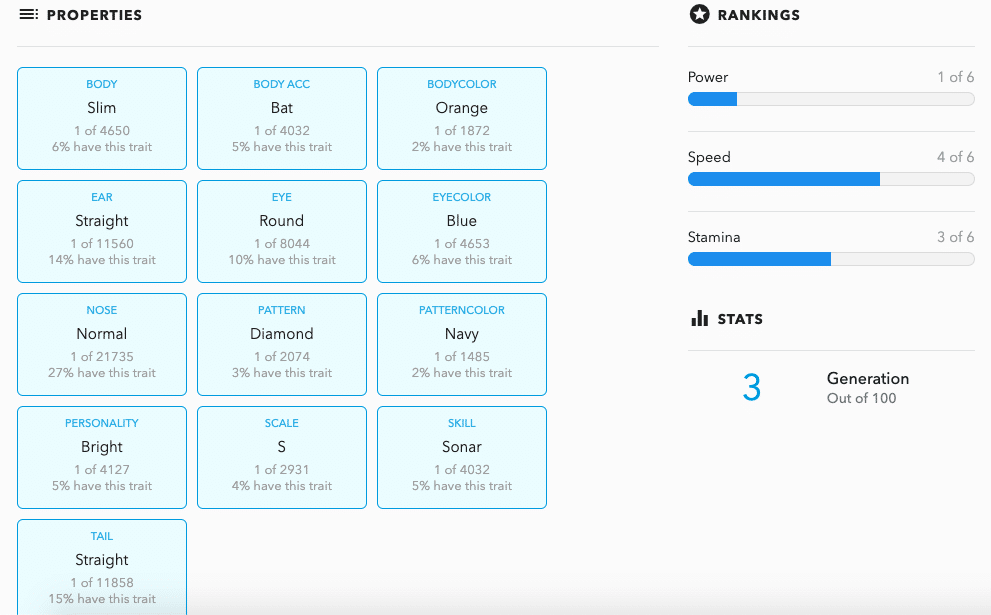
- Does your future NFT have adequate commissions? For each transaction involving an NFT, you have to pay a certain fee. It’s called capitalism. For example, OpenSea charges sellers a 2.5% transaction fee. Parting with your coins is painful, so don’t overpay just for owning a random pic — unless it’s a picture of a kitten, of course. Disregard common sense. You NEED that kitten, whatever the price.
- Are you staying on guard? NFTs are young, which means it’s hard to predict the liquidity (or the ability to sell for a beneficial price) of this or that piece. Read the news, panic, and sell when your gut tells you to do it.
Best App to Buy and Sell NFTs
Here is the list of most-recommended apps for buying NFTs, in no particular order:
- OpenSea
- Binance
- Rarible
- Nifty Gateway
- Foundation
We think that the largest NFT marketplaces make the best NFT apps. If you doubt what NFT app to download, simply head to our article on marketplaces, choose one, and search for its app.
FAQ
What are NFT trading cards?
NFT trading cards are a modern digital evolution of traditional trading cards, leveraging the technology of blockchain, predominantly Ethereum. Like other non-fungible tokens (NFTs), each trading card is a distinctive digital property that is completely unique. They can be traded on various NFT exchanges just like other non-fungible digital art tokens.
Is NFT digital art?
Yes… in most cases. Sometimes, they act as a digital representation of an asset, or even a person. You can even mint NFTs that represent your house or your room.
What crypto is used to buy NFTs?
It’s going to be Ethereum (ETH-USD) most of the time. The NFT market was historically hosted on the Ethereum blockchain technology, and because of it, ETH is required for payment.
ETH is the second most popular cryptocurrency. Right now, Ethereum is evolving into its next Pokemon stage, a proof-of-stake model ETH 2.0. Crypto experts promise better efficiency and reduced cost. A new model is also supposed to be more eco-friendly.
Is there any other currency I can buy NFTs with? Yes. Another crypto that recently got famous is Polygon (MATIC-USD). You can use it on OpenSea and several other NFT marketplaces.
Binance USD (BNB-USD) is another coin used by the Binance platform. It’s monitored by the New York State Department of Financial Services (NYDFS).
Additionally, there are many “local” NFT marketplaces that belong to a particular project or game. These often offer the option of carrying out all platform-related blockchain transactions (NFT sales included) in their native token.
Is NFT coin a good investment?
Actually, yes — as long as you invest carefully.
- It’s a very secure investment. Thanks again, Bitcoin. Thanks to your decentralization principle, it is almost impossible to hack and steal a digital asset.
- It’s a digital art you can sell at any moment. Because you have access to your NFTs at all times, filling out a transaction form will take just a few minutes.
- It’s a fun and exciting investment. NFTs allow you to make money out of thin air. Like, literally. This sounds dangerous and mesmerizing at the same time.
Although the NFT market isn’t exactly what it used to be, it can still be profitable. But, as always, you need to DYOR and stick to your investment strategy. Besides monetary profit, NFTs also often give other benefits, such as access to extra features or inclusion in a specific community.
Can you buy a part of an NFT?
NFTs can have multiple owners. It’s called fractional ownership of digital art, and it’s reflected in the percentage that each person owns.
Fractional ownership is like Japanese “kintsugi,” the art of repairing broken pottery with gold and silver. Both concepts are beautiful and chaotic.
Unlike NFTs, fractional NFTs are fungible. This means that your parts of an NFT are treated equally and can all be exchanged for each other. Smart contracts deal with these tokens so that all owners can immediately see what happens to their parts of the NFT.
What is an NFT metaverse?
The metaverse is a VR-based concept that covers all areas of life (not only games but also work, study, and communication) and has a full-fledged digital economy.
We are almost on the edge of the metaverse: exchanging bitcoins, playing real-time multiplayer games, acquiring art in NFT collections… and modding Skyrim until it crashes — that’s classic!
Digital artworks really push us into the metaverse. They serve as a virtual NFT marketplace, an art gallery, and a new method to sell real-life things like real estate or cars.
How to buy an NFT with no gas fee?
Gas is a unit of computing power required to execute a transaction on the Ethereum blockchain. Like the gas you pour into a car, this gas fuels all the specific actions you take on the blockchain. Any dealings with ETH, especially on the OpenSea platform for digital artwork and other popular NFT marketplaces, require you to pay a gas fee when you sell digital art. The Polygon crypto, on the other hand, doesn’t have gas fees. You can choose to pay in Polygon cryptocurrency from your wallet extension in the browser.
How old do you have to be to buy an NFT?
Firstly, each country has its own definition of “old enough to do things.” Lawyers call this concept “the age of majority” — it’s an age when you legally reach adulthood and become fully responsible for your own actions and decisions, including investing in stocks. In most countries, the age of majority is 18. In the US, the age of majority is 19 in Alabama, Delaware, and Nebraska, and 21 in Mississippi.
Secondly, laws don’t keep up with the latest trends in the digital market. Because of this, there is no solid definition of how old you should be to buy a digital asset. We can compare the legal age of purchasing non-fungible tokens to similar concepts, like the legal age of setting up your crypto wallet. Some companies allow 13-year-olds to open wallets with the consent of their parents.
In shorthand, you have to be 18 y.o. or older in most cases. Sometimes, you can buy NFTs even if you’re under 18 years of age. Don’t forget, one of the most well-known NFT traders was born in 2009.
So, “NFT” stands for a non-fungible token. But that’s just the tip of the iceberg.
Disclaimer: Please note that the contents of this article are not financial or investing advice. The information provided in this article is the author’s opinion only and should not be considered as offering trading or investing recommendations. We do not make any warranties about the completeness, reliability and accuracy of this information. The cryptocurrency market suffers from high volatility and occasional arbitrary movements. Any investor, trader, or regular crypto users should research multiple viewpoints and be familiar with all local regulations before committing to an investment.

